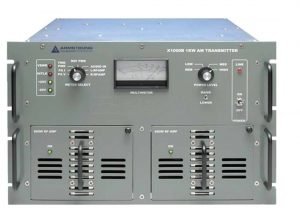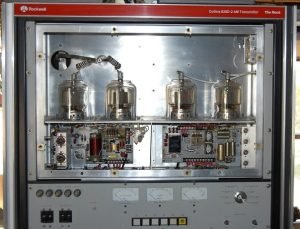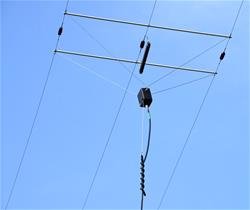
In many countries throughout the world, the AM band as a viable, reliable means for both government & commercial broadcasters to utilize has come to an end. Many predict we in the US, Canada & Mexico will see an end to widespread use of AM in about 10 years. As I’ve written before, there will probably be a handful of high-powered analog commercial & possibly government-operated AM broadcasters, along with a few dedicated HD operators that will continue to utilize 530-1700 kHz in North America. Many small & struggling AM’s are already throwing in the towel, shutting down their facilities, turning in their AM licenses to the FCC, receiving “STA” temporary authority to remain silent due to financial hardship, or outright donation of the facilities & license to non-profit community & religious organizations. In countries where AM has closed there is becoming a surplus of cheap, used AM transmitters & tuning units. It is happening here in the US & Canada too. In some instances, AM transmitters & tuning hardware can be had for FREE by simply travelling to the facility location, dismantling & removing the AM equipment. I am currently aware of at least 2 ‘freebies’ in the US & 3 in Canada by owners that merely want to be rid of the AM equipment.


Armstrong 1 kW transmitter; a true workhorse – the Collins 820D-2 AM transmitter
What to do with a chunk of frequency spectrum that has been abandoned & nobody seems to want any more? Acknowledging the world’s current mantra of ‘recycle & re-use’ there are some enterprising new operators launching new stations on the AM band based on acquisition of surplus AM transmitting equipment. A number of European countries & soon Japan have implemented “LPAM” to new applicants eager to provide radio service on the AM band. Licenses have been created similar to our own LPFM service – minimum paperwork, technical requirements, low power & non-protection from interference by other stations or electronic device emissions. First Italy, then the Netherlands & UK have led the charge to re-populate the AM band by non-commercial organizations, religious groups or individual operators with the savvy & experience to rise to the challenge of AM broadcasting. In Italy, any frequency not populated by an existing Italian high-powered broadcaster – of which there are now very few – is obtainable. Output power is restricted to a few hundred watts. In the Netherlands, frequencies once occupied by Dutch commercial & government stations, now deleted, are available. These are restricted to a few available frequencies in number & two classes of license have been created: 1-5 watts output & 100 watts output. In the UK, along with low power community stations on AM, the UK regulator Ofcam is licensing “special event” AM licenses that have a short, specific duration of broadcast time on an assigned frequency. One-time pirate operator Radio Caroline – now licensed for a full-time high-power AM – has used these multiple times in the past to launch weekend radio services for British AM listeners to enjoy. In addition, low-power hospital AM stations serving patients with news, info, talk & music plus hospital bulletins exist in many UK medical centers now. Norway & Finland are about to investigate the possible creation of LPAM based on requests from citizens & organizations to re-open the now abandoned AM spectrum in those countries. In Japan, commercial broadcasters & the government regulator have agreed to an orderly end to commercial AM broadcasting & all that will remain will be a handful of high-powered government stations (NHK Radio). Already, plans are being drawn up for an LPAM service for individuals & small community groups to implement & operate low powered AM broadcasting. Does LPAM have a future here in America?


Canadian-made Nautel J1000 transmitter; schematic of a simple wire antenna suitable for AM transmission at lower power
As I’ve opined in previous “AM Radio Today” op-eds, had the short-sighted FCC developed FM broadcasting in a more logical fashion which would have freed up AM spectrum, the launch of an LPAM service – as opposed to the LPFM service which has over-saturated the more desirable & more popular FM band with signals – could have been implemented & grown as more & more commercial AM operators “flipped” to the FM band to continue broadcasting. But…that didn’t happen. It’s still not too late to consider such a service which would make use of abandoned AM spectrum here & keep in circulation, aging but serviceable AM broadcast transmitters & tuning units. Granted, such service would be much lower powered than current commercial broadcasters & would serve much smaller population bases than currently exists. But isn’t that what the LPFM service is designed to do? Perhaps the FCC could offer some incentives to current LPFM operators to move to the AM band freeing up more FM spectrum & equipment to accommodate abandoned AM station operators still wishing to offer a commercial service to listeners. While the days of owning or leasing large fields containing multiple towers adjacent to urban centers is pretty much over thanks to escalating real estate prices for land with development potential, using simple wire antennas or tree-mounted ‘vertical antennas’ are quite viable & effective when coverage of a small area is desired.

Multi-wire “Tophat” antennas provide good AM frequency radiation
We already have one example of LPAM here in the Pacific Northwest that may be a beacon of what lies ahead for the AM band once mass abandonment & insolvency proliferate. Family Radio’s 1460 KARR lost it’s tower lease in Kirkland due to sale of the land for urban housing development. Typically, as has happened elsewhere, Family Radio could have simply shut down KARR & turned in the license to the FCC for deletion. But, that didn’t happen. Local broadcast engineer Jim Dalke, who had been maintaining the facility, purchased the license, assets & equipment from Family Radio. Although licensed for 5 kW days & 2.5 kW nights, Jim erected a simple wire antenna & transmits with 250 watts which is a power level such a simple antenna can handle. The new signal covers only a small area as compared to it’s previous facility which had coverage of much of the Seattle-Tacoma-Everett metro. However, KARR is technically licensed to Kirkland, not Seattle & has enough power & antenna radiation coverage to nicely provide that suburban community with a clean, clear AM signal. The addition of an FM translator with spectacular coverage has enhanced KARR‘s coverage into a number of neighborhoods in the Seattle area. This is an example of LPAM as we might see & hear it 10-20 years from now. The time will soon come for LPAM. Potential broadcasters, listeners & a forward-thinking FCC need to get ready for the next evolution in American AM radio broadcasting.


Some comments may be held for moderation. (New users)